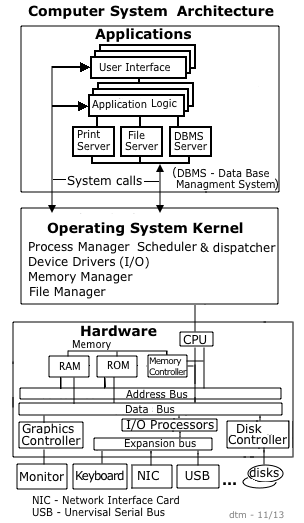| PC History | Internet History | Operating Systems | Software Development | Languages |
Under Construction 

An operating system (OS) is a collection of software that manages computer hardware resources and provides common services for application computer programs. Examples are Microsoft Windows, Apple Macintosh OS X and Linux. Originally computers using batch processing did things sequentially one process at a time, so keeping track of things was simple. Modern computers, even PCs with a single user do multiple things e.g. downloading a web page while typing an email message. Both tasks are reading and writing to the same memory and hard disk files. The operating system makes sure they don't conflict with each other by allocating time slices to each task so quickly that they seem to be running simultaneously.
There are a variety of terms describing operating systems, Real-time, Multi-user, Multi-tasking, Distributed, ...
Some history:
1954 MIT's Tape Director operating system developed for its
Whirlwind computer
Also used for the UNIVAC 1103.
The first example of a Job Control Language (JCL) driven operating system
1955 The General Motors Research Laboratories implemented an operating system for the IBM 701.
Generally considered the first operating system.
1957 BESYS (Bell Labs), for IBM 7090 and IBM 7094.
1961 CTSS (MIT's Compatible Time-Sharing System for the IBM 7094)
1962 GCOS (GE's General Comprehensive Operating System,
originally GECOS, General Electric Comprehensive Operating Supervisor) for the GE-635.
1964 DTSS Dartmouth Time Sharing System for GE computers
1964 OS/360 for IBMs S/360 series of computers
Used Job Control Language (JCL), a scripting language
to instruct the system on how to run a batch job or start a subsystem.
1965 Multics for GE-645 and Honeywell 6180 Developed by MIT, GE and Bell Labs
for the 36-bit GE-635. When Honeywell bought for GE
they used it on their 6180 (DPS-8) machines. The last version was decommissioned in 2000.
The problems of developing a major operating system is documented by by Fred Brooks in The Mythical Man-Month, which describes IBM's problems with OS/360 starting in the mid 60's.See Timeline of operating systems at Wikipedia for others in the 60's and 70's 1970 Ken Thompson, Dennis Ritchie and Brian Kernighan invented UNIX at Bell Laboratories running on the DEC (Digital Equipment Corporation) PDP-7 and 9. 1972 VM/CMS - IBM Virtual Machine 1974 MVS - Multiple Virtual Storage for IBM 370 1974 The CP/M (Control Program/Monitor also: Control Program for Microcomputers) designed by Digital Research John Torode and Gary Kildall for the 8080 chip. A version of CP/M was later written for the Z80 microporcessor 1979 Seattle Computer Products (Tim Paterson) develops SCP-DOS or 86-DOS. Basically a clone of CP/M for the 8086 processor. 1977 VMS (Open Virtual Memory System) for DEC VAX 1977 The University of California, Berkeley releases BSD UNIX (Berkeley Software Distribution) 1980 IBM comes to Microsoft for an Operating System for their new PC Gates is too busy so sends them to Digital Research for CP/M Digital Research didn't want to sign the non-disclosure agreement. Microsoft buys DOS from Seattle Computer Works for $50,000 1981 IBM releases the PC with the PC DOS operating system Microsoft sells MS-DOS for PC clones. 1981 Xerox releases the Star (Xerox 8010 Information System) with the Pilot operating system 1984 Apple releases the Macintosh with the System 1 In 1995 System 7.1 was renamed the Mac OS 1986 IBM and Microsoft release OS/2, a multitasking OS for PCs 1986 HP-UX Hewlett Packards UNIX 1990 Microsoft releases Windows 3 (the first successful version) A graphical user interface running on top of DOS 1991 Linus Torvalds began work on Linux, a Unix-Like system which he based on MINIX that initially ran on IBM PC compatible computers. There are currently many variations of Linux (Red Hat, ubuntu, OpenSUSE, Fedora, Debian, ... See Linux here. 1992 Microsoft replaces DOS with the Windows NT kernel 1993 UNIX System V - AT&T sells UNIX rights to Novell Dennis Ritchie likened this sale to the Biblical story of Esau selling his birthright. 1993 Sun Microsystems introduces the Solaris OS. A UNIX derivative for their SPARC systems. 1993 Debian is generally GNU licensed versions of Linux or BSD. 1996 Jeff Hawkins, Donna Dubinsky, and Ed Colligan invent the palm pilot A PDA Personal Digital Assistant with the Palm OS 1999 RIM releases the BlackBerry (first smaartphone?) with the BlackBerry OS 2001 Apple releases Mac OS X based on BSD Unix 2007 Apple releases the iPhone with iOS 2005 Google buys Android Inc. which they had been baking 2008 First Android-powered smart phone 2009 Windows 7 2012 Windows 8 with a redesigned user interface, designed to make it easier for touchscreen users to use Windows.See: History of Operating Systems by Rashid Bin Muhammad and at Wikipedia Architectures:
|